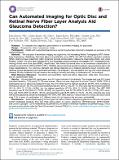Files in this item
Can automated imaging for optic disc and retinal nerve fiber layer analysis aid glaucoma detection?
Item metadata
| dc.contributor.author | Banister, Katie | |
| dc.contributor.author | Boachie, Charles | |
| dc.contributor.author | Bourne, Rupert | |
| dc.contributor.author | Cook, Jonathan | |
| dc.contributor.author | Burr, Jennifer M. | |
| dc.contributor.author | Ramsay, Craig | |
| dc.contributor.author | Garway-Heath, David | |
| dc.contributor.author | Gray, Joanne | |
| dc.contributor.author | McMeekin, Peter | |
| dc.contributor.author | Hernández, Rodolfo | |
| dc.contributor.author | Azuara-Blanco, Augusto | |
| dc.date.accessioned | 2016-04-20T15:16:45Z | |
| dc.date.available | 2016-04-20T15:16:45Z | |
| dc.date.issued | 2016-05 | |
| dc.identifier | 241578147 | |
| dc.identifier | b536ef37-2bbe-42f5-bc44-2c832b894e94 | |
| dc.identifier | 84962531833 | |
| dc.identifier | 000375942300013 | |
| dc.identifier.citation | Banister , K , Boachie , C , Bourne , R , Cook , J , Burr , J M , Ramsay , C , Garway-Heath , D , Gray , J , McMeekin , P , Hernández , R & Azuara-Blanco , A 2016 , ' Can automated imaging for optic disc and retinal nerve fiber layer analysis aid glaucoma detection? ' , Ophthalmology , vol. 123 , no. 5 , pp. 930-938 . https://doi.org/10.1016/j.ophtha.2016.01.041 | en |
| dc.identifier.issn | 0161-6420 | |
| dc.identifier.other | RIS: urn:741F62682BFE2CC7820B8C2D0ADD2B50 | |
| dc.identifier.other | ORCID: /0000-0002-9478-738X/work/60196203 | |
| dc.identifier.uri | https://hdl.handle.net/10023/8650 | |
| dc.description | Open Access funded by Department of Health UK | en |
| dc.description.abstract | Purpose: To compare the diagnostic performance of automated imaging for glaucoma. Design: Prospective, direct comparison study. Participants: Adults with suspected glaucoma or ocular hypertension referred to hospital eye services in the United Kingdom. Methods: We evaluated 4 automated imaging test algorithms: the Heidelberg Retinal Tomography (HRT; Heidelberg Engineering, Heidelberg, Germany) glaucoma probability score (GPS), the HRT Moorfields regression analysis (MRA), scanning laser polarimetry (GDx enhanced corneal compensation; Glaucoma Diagnostics (GDx), Carl Zeiss Meditec, Dublin, CA) nerve fiber indicator (NFI), and Spectralis optical coherence tomography (OCT; Heidelberg Engineering) retinal nerve fiber layer (RNFL) classification. We defined abnormal tests as an automated classification of outside normal limits for HRT and OCT or NFI ≥ 56 (GDx). We conducted a sensitivity analysis, using borderline abnormal image classifications. The reference standard was clinical diagnosis by a masked glaucoma expert including standardized clinical assessment and automated perimetry. We analyzed 1 eye per patient (the one with more advanced disease). We also evaluated the performance according to severity and using a combination of 2 technologies. Main Outcome Measures: Sensitivity and specificity, likelihood ratios, diagnostic, odds ratio, and proportion of indeterminate tests. Results: We recruited 955 participants, and 943 were included in the analysis. The average age was 60.5 years (standard deviation, 13.8 years); 51.1% were women. Glaucoma was diagnosed in at least 1 eye in 16.8%; 32% of participants had no glaucoma-related findings. The HRT MRA had the highest sensitivity (87.0%; 95% confidence interval [CI], 80.2%–92.1%), but lowest specificity (63.9%; 95% CI, 60.2%–67.4%); GDx had the lowest sensitivity (35.1%; 95% CI, 27.0%–43.8%), but the highest specificity (97.2%; 95% CI, 95.6%–98.3%). The HRT GPS sensitivity was 81.5% (95% CI, 73.9%–87.6%), and specificity was 67.7% (95% CI, 64.2%–71.2%); OCT sensitivity was 76.9% (95% CI, 69.2%–83.4%), and specificity was 78.5% (95% CI, 75.4%–81.4%). Including only eyes with severe glaucoma, sensitivity increased: HRT MRA, HRT GPS, and OCT would miss 5% of eyes, and GDx would miss 21% of eyes. A combination of 2 different tests did not improve the accuracy substantially. Conclusions: Automated imaging technologies can aid clinicians in diagnosing glaucoma, but may not replace current strategies because they can miss some cases of severe glaucoma. | |
| dc.format.extent | 9 | |
| dc.format.extent | 954250 | |
| dc.language.iso | eng | |
| dc.relation.ispartof | Ophthalmology | en |
| dc.subject | RA0421 Public health. Hygiene. Preventive Medicine | en |
| dc.subject | RE Ophthalmology | en |
| dc.subject | NDAS | en |
| dc.subject | SDG 3 - Good Health and Well-being | en |
| dc.subject.lcc | RA0421 | en |
| dc.subject.lcc | RE | en |
| dc.title | Can automated imaging for optic disc and retinal nerve fiber layer analysis aid glaucoma detection? | en |
| dc.type | Journal article | en |
| dc.contributor.institution | University of St Andrews. School of Medicine | en |
| dc.identifier.doi | 10.1016/j.ophtha.2016.01.041 | |
| dc.description.status | Peer reviewed | en |
This item appears in the following Collection(s)
Items in the St Andrews Research Repository are protected by copyright, with all rights reserved, unless otherwise indicated.

